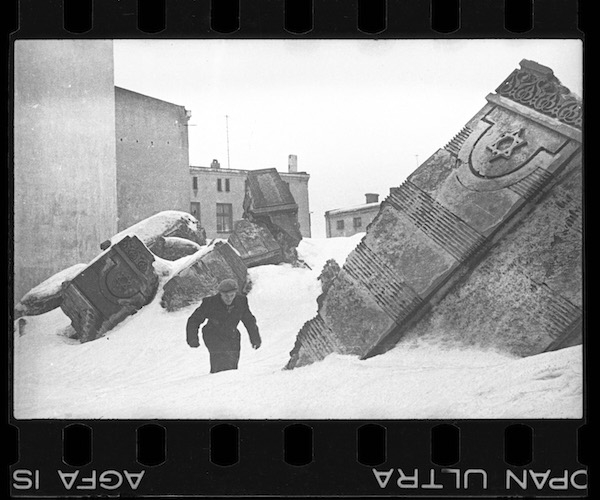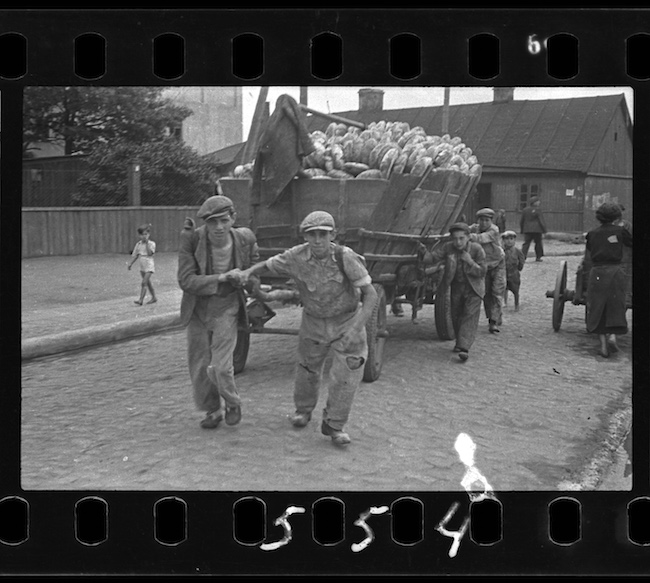Visual Arts Feature: The Photographs of Henryk Ross — An Eye on the Banality of Evil
In the remarkable images of Henryk Ross, Nazi evil is exposed through a kind of heroic voyeurism.
Memory Unearthed: The Lodz Ghetto Photographs of Henryk Ross, at the Museum of Fine Arts, Boston, MA, March 25 through July 17.

Man walking in winter in the ruins of the synagogue on Wolborska street, destroyed by the Germans in 1939. Photo: Henryk Ross, courtesy of Museum of Fine Arts, Boston.
By Robert Israel
The late film director Sidney Lumet — whose 1964 movie The Pawnbroker won acclaim for his frank dramatization of a Holocaust survivor’s attempt to create a new life in America — once commented that the Nazi’s orchestrated mass slaughter of 6 million Jews was unique in human history because it was “the first time that one’s neighbors turned in their fellow neighbors to be murdered.”
The MFA’s remarkable exhibit of photographs by Henryk Ross (1910-1991) elaborates on Lumet’s observation by exposing yet another layer of Nazi depravity. For the brutal German overlords — who occupied Poland and built, with the assistance of eager Polish collaborators, the sites of their largest human extermination camps — it was not enough to round up the Jews, imprison them, force them to work as slaves and then, after these men, women, and children had been tortured, starved and broken, to systematically murder them. No, the Nazis wanted to make sure that all of their barbarity was expertly documented. This is yet another illustration of what Hannah Arendt controversially termed “the banality of evil”; there had to be proof of a job well done, snapshots of oblivion. Hitler’s “the final solution” would not be accomplished until a “museum of a vanished race” had been erected in Berlin, a monument that showcased the Nazis complete and systematic eradication of the Jewish people.
The current MFA exhibit reminded me of another exhibit that toured globally over two decades ago, sponsored in part by the Smithsonian, titled The Precious Legacy. That show examined just how monomaniacal the Nazis’ scheme was: it displayed household items pilfered from ransacked Jewish homes (candelabra, silver tea sets, embroidered table linen, alms boxes, Torah sconces) that had been discovered after the war in massive warehouses in Prague. Enslaved Jewish archivists had been made to record each item in record books before they were sent to their deaths in Auschwitz.
The Lodz ghetto, established in 1939 in Poland, was the second largest Jewish enclave of its kind in Europe. More than 230,000 Jews lived there before the war. Like the trapped Prague activists, Henryk Ross was assigned to chronicle the process of eradication: he photographed the imperiled Jewish community, selected for the task because he had worked for the Polish press.
But Ross gave himself another mission — to document the deportations of his fellow Jews, to serve as proof of the monumentally murderous actions he was witnessing, day after sorrowful day.
“His camera became incredibly important and compelling to not only record images he was assigned to capture, but to be used as a weapon in an act of resistance, to secretly record the fate of his neighbors,” explains Kristen Gresh, MFA curator.

Henryk Ross photographing for identification cards, Jewish Administration, Department of Statistics. Photo: Henryk Ross, courtesy of the Museum of Fine Arts Boston.
By the end of the war, in 1944, only a handful of Jews survived. Ross was among those who were lucky enough to make it though the hellish experience. His survival defied fate, but what made this man even more amazing was his courageous act of defiance — he had clandestinely preserved his negatives (hiding them in his backyard at 12 Jagielonska Street) so that the world would one day see the crimes he had recorded.
“I buried my negatives in the ground in order that there should be some record of our tragedy….I was anticipating the total destruction of Polish Jewry. I wanted to leave a historical record of our martyrdom,” Ross wrote.
It should not come as a surprise that the Museum of Fine Arts Boston has mounted this exhibit; it originated at the Art Gallery of Ontario (AGO) in Toronto, where MFA director Matthew Teitelbaum served as AGO curator and, later, as its CEO and director. Teitelbaum oversaw the AGO installation of the Ross exhibit and contributed the foreword to the show’s catalog.
“It is, in a deep and unsettling way,” Teitelbaum wrote, “difficult to make sense of these images.” Yet in the foreword he attempts to do just that, describing what it must have felt like to be trapped in the ghetto: “…no roads lead elsewhere…no light shines through windows; walls, fences and closed door separate but do not join.”
Unlike Teitelbaum, I do not find it “difficult” to “make sense” of the images. I know first-hand what these pictures mean because I have seen similar images in various circumstances. I have interviewed many survivors during my years as a newspaper editor, and have lived among several survivors – and these included members of my family — when I was a youngster. Long before Memory Unearthed, I had been shown the same kind of photographs, selections from private collections acquired by the survivors themselves. I have also met men who liberated the concentration camps, and they gave me access to their personal collections of photographs.
Still I understand Teitelbaum’s bewilderment. It is difficult to make rational sense of what is depicted in these photographs — to see the horror perpetrated by one neighbor upon another — without shaking one’s head in disbelief. And what causes additional heartache and agony is that that many of the men, women, and children who willingly posed for many of these portraits look back at Ross with a glint in their eyes. They had absolutely no motivation, none whatsoever, to feel that way in a world bereft of kindness and comforts, aside from those they could scrounge up for themselves. Wearing heavy overcoats, to ward off the damp chill of Polish winters between in 1940-1944, they look back at the photographer — yellow Stars of David pinned to their lapels, insignias of death. And yet they act as if the forced transportation, among the other humiliations they were made to endure, was just one of the many depravations of life to be suffered during wartime. Walled off from their neighbors, they could glimpse from afar the comforts they were denied; they were made to produce clothing, shoes, and loaves of bread for no renumeration on back-breaking assembly lines. This abysmal world was their dying world, a world that became more skeletal by the hour, a world engulfed by toxic fumes.

Men hauling a cart for bread distribution. Photo: Henryk Ross, courtesy of Museum of Fine Arts, Boston.
The exhibit does not include photographs of Nazi violence, but it is suggested in many of the images, particularly those in which Jews are herded onto cattle cars, or seen from behind barbed wire as they are marched toward holding areas, stripped of their belongings. There are no pictures of starvation, though in one we see a boy keeling over on the sidewalk with the caption, “Falling on the street from hunger.” And there is a group shot of Jews shown from afar in a field: they are on their hands and knees, searching for food scraps in a garbage dump. There are no images of the dead, the victims of the Nazi crematoria, but mortality lurks in every nook and cranny, particularly in a haunting portrait of two workers hoisting a corpse into a horse-drawn tram.
“In the beginning the burials in the ghetto were made individually,” Ross recorded. “Later the collection of bodies was on a massive scale.”
“The exhibit shows both the assigned propagandized portraits of Jews working in a mattress factory, for example, as well as those Ross took in hiding, aiming his lens through holes in a nearby building to show the deportations,” explains curator Gresh. “Had he been discovered taking these covert photographs, he surely would have been murdered.”
This compelling sense of secrecy, of illicit exposure, is one of the reasons that these photographs, after so many decades and so much writing about the Holocaust, maintain their sense of urgency. The banality of Nazi evil is exposed through a kind of heroic voyeurism: it is the ‘crime’ of finding, amid the silent anguish of Jews condemned to death, startling signs of humanity.
Robert Israel writes about theater, travel, and the arts, and is a member of Independent Reviewers of New England (IRNE). He can be reached at risrael_97@yahoo.com.
